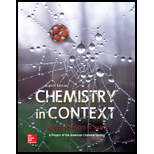
Concept explainers
(a)
Interpretation:
The mass loss corresponds to
Concept Introduction:
Einstein’s mass-energy equivalence equation clearly depicts the relation between mass and energy. The mass-energy equivalence equation is as follows,
Here,
Unit of mass and speed should be taken in SI unit in order to convert energy in terms of joule.
From the equation it is clear that, anything that has mass will also have energy.
(a)
Explanation of Solution
According to Einstein’s equation, the mass change corresponds to the release of
Rearranging the equation in terms of mass change is given below.
Given,
Substituting these values in the above equation gives mass loss as follows,
Therefore, the mass loss corresponds to the release of
(b)
Interpretation:
For the energy
Concept Introduction:
During the combustion of methane, methane reacts with oxygen to produce carbon dioxide and water with the release of energy.
The balance chemical equation for the combustion of methane is as follows,
For
(b)
Explanation of Solution
For the release of
The mass loss for the releases of
Therefore, the ratio of mass of methane burned by producing
That is, the ratio is
(c)
Interpretation:
The applicability of Einstein’s equation for nuclear reaction than the
.
Concept Introduction:
Einstein’s mass-energy equivalence equation clearly depicts the relation between mass and energy. The mass-energy equivalence equation is as follows,
Here,
Unit of mass and speed should be taken in SI unit in order to convert energy in terms of joule.
From the equation it is clear that, anything that has mass will also have energy.
(c)
Explanation of Solution
In a chemical reaction, the amount of energy released for each gram of reactant is very much smaller than the energy released in a nuclear reaction for each gram of reactant.
So, in a chemical reaction only very less amount of mass is converted into energy whereas in nuclear reaction the mass converted will be high corresponds to the higher energy produced. Therefore the Einstein’s equation is more applicable to nuclear reaction.
Want to see more full solutions like this?
Chapter 7 Solutions
Chemistry in Context
- Show the mechanism steps to obtain the lowerenergy intermediate: *see imagearrow_forwardSoap is made by the previous reaction *see image. The main difference between one soap and another soap isthe length (number of carbons) of the carboxylic acid. However, if a soap irritates your skin, they mostlikely used too much lye.Detergents have the same chemical structure as soaps except for the functional group. Detergentshave sulfate (R-SO4H) and phosphate (R-PO4H2) functional groups. Draw the above carboxylic acidcarbon chain but as the two variants of detergents. *see imagearrow_forwardWhat are the reactions or reagents used? *see imagearrow_forward
- The two pKa values of oxalic acid are 1.25 and 3.81. Why are they not the same value? Show the protontransfer as part of your explanation. *see imagearrow_forwardасть Identify all the bonds that gauche interact with C-OMe in the most stable conformation of the above compound.arrow_forwardPredict the reactants used in the formation of the following compounds using Acid-Catalyzed dehydration reactionarrow_forward
- Can I please get help with this?arrow_forward.. Give the major organic product(s) for each of the following reactions or sequences of reactions. Show ll relevant stereochemistry [3 ONLY]. A H Br 1. NaCN 2 NaOH, H₂O, heat 3. H3O+ B. CH₂COOH 19000 1. LiAlH4 THF, heat 2 H₂O* C. CH Br 1. NaCN, acetone 2 H3O+, heat D. Br 1. Mg. ether 3. H₂O+ 2 CO₂ E. CN 1. (CH) CHMgBr, ether 2 H₂O+arrow_forwardAssign this COSY spectrumarrow_forward
 ChemistryChemistryISBN:9781305957404Author:Steven S. Zumdahl, Susan A. Zumdahl, Donald J. DeCostePublisher:Cengage Learning
ChemistryChemistryISBN:9781305957404Author:Steven S. Zumdahl, Susan A. Zumdahl, Donald J. DeCostePublisher:Cengage Learning ChemistryChemistryISBN:9781259911156Author:Raymond Chang Dr., Jason Overby ProfessorPublisher:McGraw-Hill Education
ChemistryChemistryISBN:9781259911156Author:Raymond Chang Dr., Jason Overby ProfessorPublisher:McGraw-Hill Education Principles of Instrumental AnalysisChemistryISBN:9781305577213Author:Douglas A. Skoog, F. James Holler, Stanley R. CrouchPublisher:Cengage Learning
Principles of Instrumental AnalysisChemistryISBN:9781305577213Author:Douglas A. Skoog, F. James Holler, Stanley R. CrouchPublisher:Cengage Learning Organic ChemistryChemistryISBN:9780078021558Author:Janice Gorzynski Smith Dr.Publisher:McGraw-Hill Education
Organic ChemistryChemistryISBN:9780078021558Author:Janice Gorzynski Smith Dr.Publisher:McGraw-Hill Education Chemistry: Principles and ReactionsChemistryISBN:9781305079373Author:William L. Masterton, Cecile N. HurleyPublisher:Cengage Learning
Chemistry: Principles and ReactionsChemistryISBN:9781305079373Author:William L. Masterton, Cecile N. HurleyPublisher:Cengage Learning Elementary Principles of Chemical Processes, Bind...ChemistryISBN:9781118431221Author:Richard M. Felder, Ronald W. Rousseau, Lisa G. BullardPublisher:WILEY
Elementary Principles of Chemical Processes, Bind...ChemistryISBN:9781118431221Author:Richard M. Felder, Ronald W. Rousseau, Lisa G. BullardPublisher:WILEY





